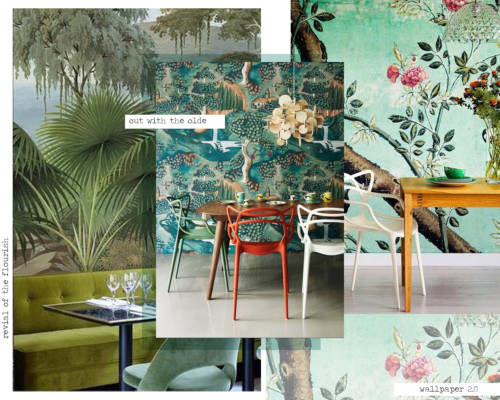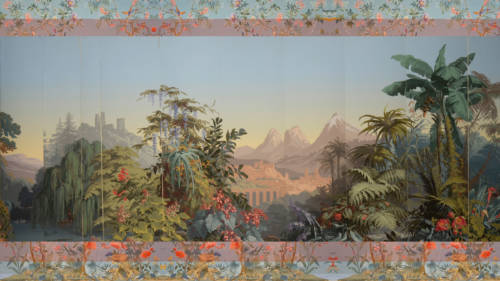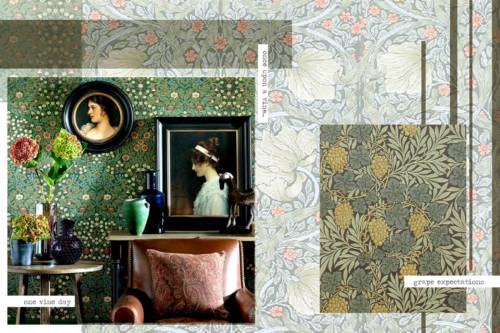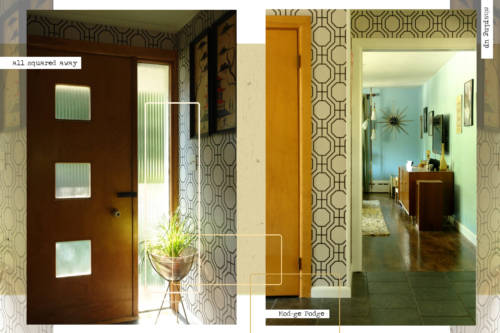Floral Wallpaper: A Look Back at the Future of Design
Until recently, floral wallpaper has lived on the fringes of interior design, condemned to an “old fashioned” aesthetic: it seems to evoke either the quaint attic room of an English bed-and-breakfast or the peeling walls of a long abandoned house. Either way, it has undeniably old character; for the modern consumer, it is a staid relic from a distant time. But in the last few seasons, we’ve seen a resurgence in floral wallpapers, reimagined in chic fresh colors and used sparingly against a single wall, infusing nature where it might not otherwise live. These new styles impart vigor and novelty to a long and storied tradition, one nearly as old as civilization itself.
The origins and development of floral wallpaper are tenuous at best– it is an especially fragile artifact, frequently covered up by layers of paint or more fashionable décor. The earliest, most primitive renditions of floral wallpaper can be traced all the way back to cave paintings, when humans would embellish walls with what they saw around them (typically animals, but in some places natural motifs).
A more formal, genealogical history of wallpaper begins shortly after the invention of paper in China in 105 B.C.E. As a logical extension of the new medium, Chinese artists would paint luxurious outdoor scenes on paper and would hang their works on the wall to bring some of nature’s splendor indoors; these early creations are considered the predecessors to modern wallpaper, floral or otherwise.
Wallpaper officially came to Europe in the 15th century courtesy of Eastern Asia, as new trade routes expanded. Cheaper to make and a great deal more adaptable than tapestries and leather hangings popular in the Middle Ages, these early precursors focused mostly on political and religious designs, eventually moving into geometric patterns. By the 1600s, flock wallpaper had been developed and was ushering in a more nature focused aesthetic.
Floral prints were especially popular in England (where they have remained an engrained feature of the traditional British aesthetic), while countries like Holland and Switzerland favored wallpapers that imitated woodgrain. With the advent of color printing in the late 17th century and the ability to join several sheets of paper together in a roll, the market for wallpapers began to expand, embracing larger, more complex designs. Panoramas became the vogue, moving away from repetition and into wide expanses of natural scenes; outside of wealthy homes, the wallpapers were installed in public spaces as a service to educate the unwieldly masses.
The height of floral wallpaper came during the Rococo and Victorian eras of the 18th and 19th centuries. During the former, floral wallpaper was characterized by its lavishly intricate designs and pastel colors, while the latter had a more somber, geometric approach. Amid this period, however, wallpaper lost its aristocratic airs. With the advent of the Industrial Revolution, machines could now easily and quickly produce intricate designs at a cheap, rapid rate. No longer a symbol of elite craftsmanship, wallpaper lost its status as an exclusive token of the wealthy and became standard among the middle and working classes. Subsequently, it began to appear as a popular literary motif, indicative of a character’s deceit or vanity. Though William Morris is famous for the hand-printed, natural designs he produced from the 1860s on, his popularity during his own life was limited to artist friends; his later influence vastly overshadows any impact on his contemporaries. (In fact, Oscar Wilde famously despised Morris’s designs.)
During the 20th century, floral wallpaper became a mundane element of decor, slowly ebbing in popularity as the larger genre of wallpaper dwindled in esteem. Modernism seemed especially to usher out the age of wallpaper in favor of stark, plain walls, and while geometric wallpaper enjoyed a brief revival during the 60s and 70s, by the end of the 80s, wallpaper writ large– particularly floral and nature inspired wallpaper– had become a token of suburban dowdiness (recall Freaks and Geeks‘ kitchen). With the advent of the new millennia, wallpapers (especially nature-inspired ones) had moved into an entirely new space: computers and phones.
Today, wallpaper still carries tacky connotations because it so often imitates other material– it seems to remind people of what it is not rather than what it is. Floral prints are frequently weighted down by a certain frumpiness– a stale aura accumulated over centuries. But this new, distinctly modern wave of prints, more closely embraces the look and palette of real plants, which goes hand-in-hand with the trendy interest in “natural living”. Yet at its most essential, it is still the same impulse that unifies floral wallpapers across time: a desire to unite with the natural world, to keep nature as an essential point of navigation in the contemporary landscape, and to hope that even the most ephemeral imitation carries with it the power of nature and all that it has come to suggest.




































